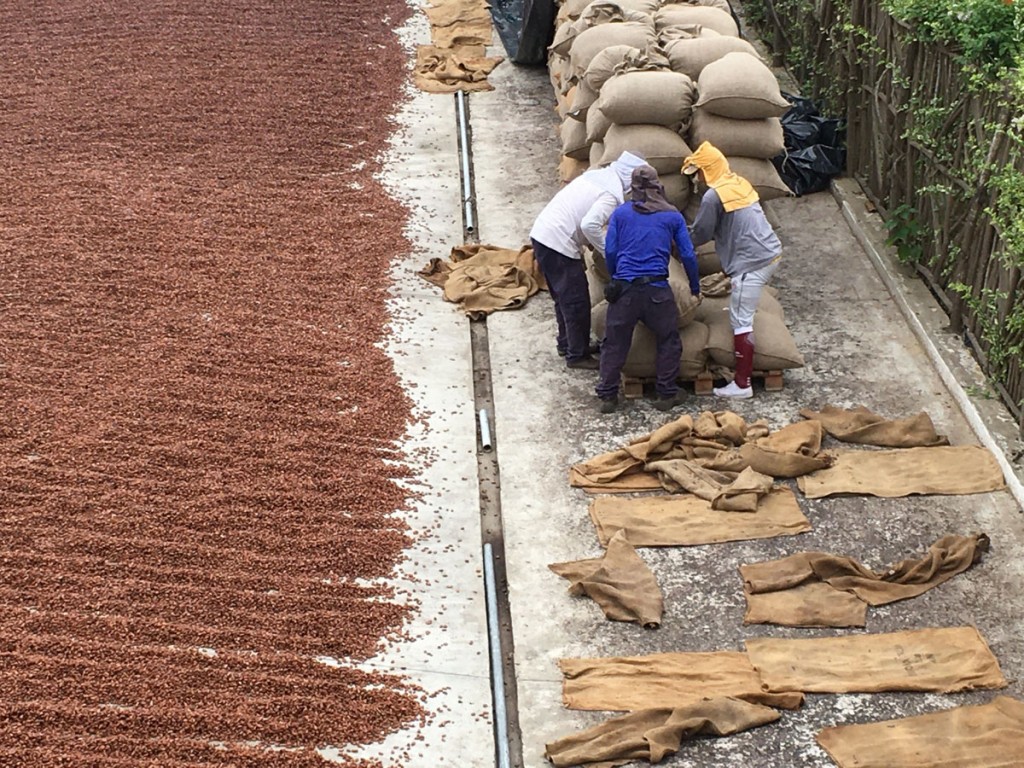Page 1: Ecuadorian Cacao
Page 2: Cacao Shipping
Page 3: What’s Next for Ecuadorian Cacao?
Page 4: Global Cacao Trade
Ecuador, the birthplace of cacao, produces some of the world’s very best cacao for producing premium chocolate. But with only a sliver of market share how the business expands in the future is a vexing question.
At the picture-postcard perfect Hacienda Victoria, about an hour’s drive southwest of the Ecuadorian port city of Guayaquil, row upon row of cacao trees line a rolling terrain. Workers pick and gather the ripened cacao pods, which come in warm hues of yellow, red and purple, depending on the variety. Laborers husk the pods, then carry sacks of cacao beans to and from sheds where exacting fermentation takes place in large wooden crates. Finally, the beans are dried in the tropical sun.

These beans will shortly be shipped by container from Guayaquil to Yokohama or Amsterdam where they will be roasted and ground, forming the foundation of some of the world’s most upscale chocolate.
Victoria grows only “Aruba Nacional.” This distinctly Ecuadorian variety is classified as “cacao fino de aroma,” by cocoa’s international governing body. Fine cacao constitutes only about 5% of global production and is considered the world’s top quality beans. They attract enormous premiums, as much as double the price of the mass-grown cacao. One industry estimate a few years back asserted that Ecuador accounts for almost two-thirds of fine aroma beans in the world.
Ecuadorian Cacao
With 700 hectares producing 1,400 tons annually, the decade-old Hacienda Victoria is Ecuador’s single biggest producer of Nacional and its single biggest exporter of this prized variety.
“This is the future of cacao,” said Andres Guzman, Victoria’s co-founder and executive director, as he surveys the farm from an open-air pavilion overlooking a small lake.
The Future and the Past
Ecuador is the birthplace of cacao, tracing a heritage back more than 5,000 years. This South American country that straddles the Equator was cacao’s global epicenter until the early 1900s, when disease ravaged the trees. Bananas eventually replaced cacao as the country’s main agricultural export.
Meanwhile, Ivory Coast and Ghana came to dominate the cacao trade. These two West African nations now produce some 60% of global supply, which amounts to about 4.5 million tons annually. It’s a $15 billion commodity, while chocolate itself is a $100 billion industry.
However, when it comes to quality, there’s no contest. Ecuadorian cacao is far superior to that found in Africa.
“West African cocoa has only a couple of different varieties, while in Latin America, there are hundreds,” explained Marika van Santvoort, who heads the Amsterdam-based cocoa consultancy and logistics firm Moving Cocoa. “Those varieties are very complex. The flavor is much more complicated and layered.”
In recent years, Ecuadorian cacao has made a comeback. Ecuador is now the world’s third ranking cacao exporter. Over the past 1 1/2 decades, Ecuador’s cacao output tripled. Acreage was added, primarily through conversion from other crops, most notably bananas, where there’s a cap on acreage and fear of fungal threat, but also rubber and palm oil plantations. Cacao yields have greatly heightened as well, increasing from 0.2 or 0.3 tons per hectare to as much as 1.5 or 2.0 tons.
There are many elements necessary if Ecuador wants to increase the underlying worth of its exports. Nacional is one important factor. So, too, is the professionalization and sustainability of farms.
Local agro-businesses are improving everything from growing techniques to packaging. They are looking into novel new uses for the plant, including juice from the pulp, and even toothpaste from the bean shells.
“Ecuador is the mecca of technology and innovation in cacao,” maintained Guzman, whose own farm is a model of modern agronomy, social responsibility and exacting technical standards.
Supply chains have been strengthened and solidified. Highways have been built and continue to be well-maintained.

Follow us on social media: